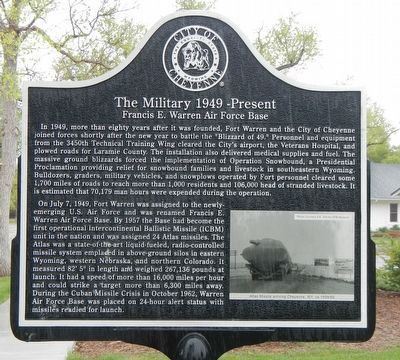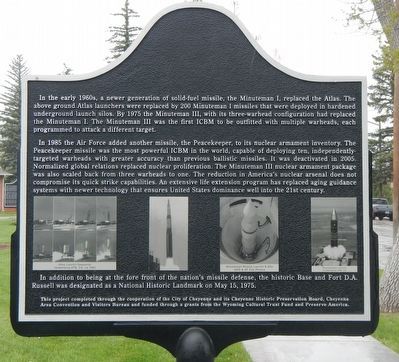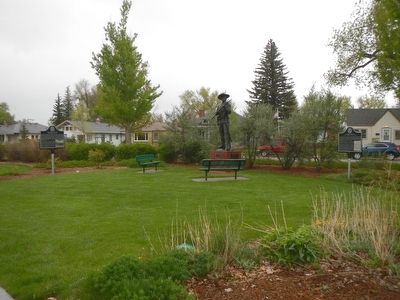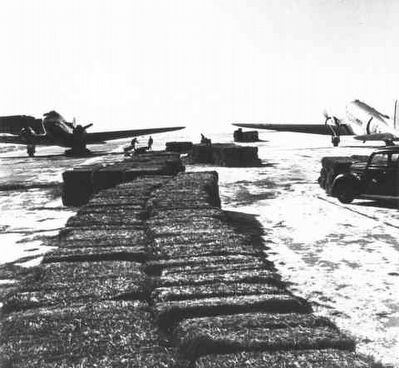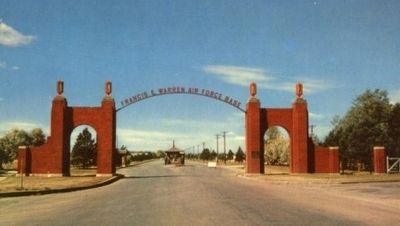Cheyenne in Laramie County, Wyoming — The American West (Mountains)
The Military 1949-Present
Francis E. Warren Air Force Base
Inscription.
In 1949, more than eighty years after it was founded, Fort Warren and the City of Cheyenne joined forces shortly after the new year to battle the "Blizzard of 49." Personnel and equipment from the 3450th Technical Training Wing cleared the City's airport, the Veterans Hospital, and plowed roads for Laramie County. The installation also delivered medical supplies and fuel. The massive ground blizzards forced the implementation of Operation Snowbound, a Presidential Proclamation providing relief for snowbound families and livestock in southeastern Wyoming. Bulldozers, graders, military vehicles, and snow plows operated by Fort personnel cleared some 1,700 miles of roads to reach more than 1,000 residents and 106,000 head of stranded livestock. It is estimated that 70,179 man hours were expended during the operation.
On July 7, 1949, Fort Warren was assigned to the newly emerging U.S. Air Force and was renamed Francis E. Warren Air Force Base. By 1957 the Base had become the first operational Intercontinental Ballistic Missile (ICBM) unit in the nation and was assigned 24 Atlas missiles. The Atlas was a state-of-the-art liquid-fueled, radio controlled missile system emplaced in above-ground silos in eastern Wyoming, western Nebraska, and northern Colorado. It measured 82' 5" in length and weighed 267,136 pounds at launch. It had a speed of more than 16,000 miles per hour and could strike a target more than 6,000 miles away. During the Cuban Missile Crisis in October 1962, Warren Air Force Base was placed on 24-hour alert status with missiles readied for launch.
In the early 1960s, a newer generation of solid-fuel missile, the Minuteman I, replaced the Atlas. The above ground Atlas launchers were replaced by 200 Minuteman I missiles that were deployed in hardened underground launch silos. By 1975 the Minuteman III, with is three-warhead configuration warheads had replaced the Minuteman I. The Minuteman III was the first ICBM to be outfitted with multiple warheads, each programmed to attack a different target.
In 1985 the Air Force added another missile, the Peacekeeper, to its nuclear armament inventory. The Peacekeeper missile was the most powerful ICBM in the world, capable of deploying ten, independently-targeted warheads with a greater accuracy than previous ballistic missiles. It was deactivated in 2005. Normalized global relations replaced nuclear proliferation. The Minuteman III nuclear package was also scaled back from three warheads to one. The reduction in America's nuclear arsenal does not compromise its quick strike capabilities. An extensive program has replaced aging guidance systems with newer technology that ensures United States dominance well into the 21st century.
In
addition to being at the fore front of the nation's missile defense, the historic Base and Fort D.A. Russell was designated as a National Historic Landmark on May 15, 1975.
Erected by City of Cheyenne, Cheyenne Historic Historic Preservation Board, Cheyenne Area Convention and Visitors Board, Wyoming Cultural Trust Fund and Preserve America.
Topics. This historical marker is listed in these topic lists: Disasters • Forts and Castles • War, Cold.
Location. 41° 8.721′ N, 104° 50.184′ W. Marker is in Cheyenne, Wyoming, in Laramie County. Marker is at the intersection of Randall Avenue and McComb Avenue, on the right when traveling east on Randall Avenue. Touch for map. Marker is at or near this postal address: 1399 Randall Ave, Cheyenne WY 82001, United States of America. Touch for directions.
Other nearby markers. At least 8 other markers are within walking distance of this marker. The Military 1867-1890 (a few steps from this marker); "Buffalo Soldiers" (a few steps from this marker); The Military 1867-1949 (within shouting distance of this marker); 1980 Capitol North National Historic District (approx. ¾ mile away); Early Cheyenne Reservoir (approx. 0.8 miles away); Camp Carlin (approx. 0.8 miles away); Cheyenne Frontier Days™ (Part I)
(approx. 0.8 miles away); The Trails (Part III) (approx. 0.8 miles away). Touch for a list and map of all markers in Cheyenne.
More about this marker. This marker is in a small triangular park bounded by Randall and McComb Avenues and West 32nd Street.
Also see . . .
1. The Notorious Blizzard of 1949 - WyoHistory. The blizzard started on Sunday Jan. 2, 1949 and proved the worst of the century. The first storm would be followed by two more months of snow and bitter cold. The National Weather Service eventually reported 12 people dead in Wyoming after the first storm. Twenty-eight more died in western South Dakota, Colorado and Nebraska. (Submitted on June 13, 2016, by Barry Swackhamer of Brentwood, California.)
2. Intercontinental Ballistic Missile - Wikipedia. The U.S. initiated ICBM research in 1946 with the RTV-A-2 Hiroc project. This was a three-stage effort with the ICBM development not starting until the third stage. However, funding was cut after only three partially successful launches in 1948 of the second stage design, used to test variations on the V-2 design. With overwhelming air superiority and truly intercontinental bombers, the newly forming US Air
Force did not take the problem of ICBM development seriously. Things changed in 1953... The Atlas A first flew on 11 June 1957; the flight lasted only about 24 seconds before the rocket blew up. The first successful flight of an Atlas missile to full range occurred 28 November 1958. (Submitted on June 13, 2016, by Barry Swackhamer of Brentwood, California.)
Credits. This page was last revised on June 16, 2016. It was originally submitted on June 13, 2016, by Barry Swackhamer of Brentwood, California. This page has been viewed 332 times since then and 12 times this year. Photos: 1, 2, 3, 4, 5. submitted on June 13, 2016, by Barry Swackhamer of Brentwood, California.
